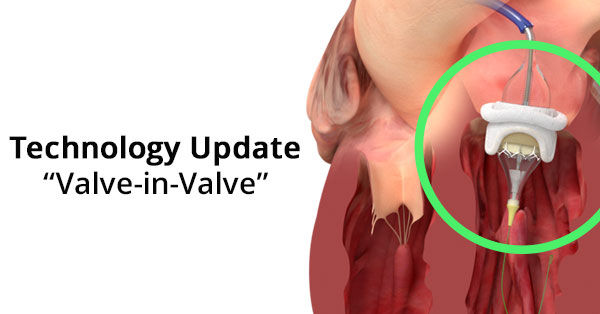Surgeon Q&A: What About “Valve-in-Valve” Procedures for Small Tissue Valves?
By Adam Pick on November 22, 2017
Given all the recent developments about “Valve-in-Valve” procedures, my inbox is swelling up with questions. For example, Connie asked me, “I had my aortic valve replaced in 2014. What are the chances of Valve-in-Valve replacement for smaller sizes such as 21mm Edwards Magna Ease pericardial valve?”

I loved Connie’s question as it raises so many critical elements of valve therapy including valve size, valve re-operations and the new transcatheter procedures that are just now receiving FDA approval. For that reason, I wanted a “Rock Star” response to help our community learn more.

So, I reached out to Dr. Eric Roselli, who is the Chief of Adult Cardiac Surgery and the Surgical Director of the Aorta Center at the Cleveland Clinic. So you know, Dr. Roselli has successfully treated many patients from our community including Denise Kirchner, John Dobry, Matt Miller and Mark Ridder. You should also know that Dr. Roselli has been a personal friend of mine for 25+ years. We attended the University of Michigan together and we were even in the same fraternity. Amazing coincidence, right?
With all that said… I was very excited to hear how Eric, I mean Dr. Roselli, would respond to Connie’s question.
Dr. Roselli Says…
In his note to me, Dr. Roselli wrote:
This is a very important question, Connie.
In general when it comes to the size of a bioprosthesis, the bigger it is the more hemodynamically efficient it is. We have recently published data from the Cleveland Clinic that demonstrated that the more efficient the valve the more durable it may be. For these reasons we always try to insert the largest valve that we can place safely. For some people the opening to the their left ventricle is small and won’t allow for the placement of a size 25mm or greater valve. If the patient is also small or significantly limited in their activities (for example, due to severe arthritis) then they may not need a large valve to achieve the desired result of relieving the burden of aortic stenosis. For younger patients, however, we may make greater efforts to place a larger valve by enlarging the opening to the heart (with one of several options like root enlargement or root replacement).
Now that the prospect of having a Valve-in-Valve replacement is feasible this issue is of more importance. Typically, I worry about the durability of placing a Valve-in-Valve into a smaller degenerated bioprosthesis because of the risk for patient-prosthesis-mismatch (PPM) – meaning that the resultant orifice of the new valve will be too small to allow adequate blood flow in relation to the demands of the patient’s body size. This issue may also limit the durability of the valve. For these reasons, when a patient who presents with a small degenerated bioprosthesis is low risk for surgery, surgical re-replacement is the best option. For some, particularly older patients with significant burden of other medical conditions, then our goals of therapy may be different and always must be viewed in the context of the risk of the procedure. For some of these higher risk patients presenting with smaller bioprostheses we have been able to “get away” with doing a Valve-in-Valve TAVR procedure. Depending on the type of valve, some operators have even described the procedure of cracking open the stent of the old valve to allow for a bigger valve.
In summary, for a high risk patient even with a 21mm bioprosthesis, Valve-in-Valve TAVR may be a safer procedure, and for a lower risk patient a redo Surgical Aortic Valve Replacement (SAVR) may be the safer procedure. What is most important to remember is that SAVR and TAVR are complementary and not competitive procedures. For each patient the best treatment option is the one tailored for that patient’s needs, treatment goals, and the ability to tolerate the various risks of the different procedures. Highly experienced centers who deal with many of these more difficult treatment decisions can help you with a heart team approach to determine the best choice for you.
Hope this helps and thanks for bringing up this very important discussion. — Dr. Roselli
Thanks Connie! Thanks Dr. Roselli!
No doubt. That was awesome. Thanks to Connie for asking the question. Thanks to Dr. Eric Roselli for sharing his clinical experiences and research with our community. And, thanks so much to Dr. Roselli’s team and the Cleveland Clinic for taking such great care of our patients.
- See Dr. Eric Roselli’s Interactive Surgeon Profile
- Discover the Cleveland Clinic Heart Valve Microsite
- Learn About the FDA Approval for Aortic & Mitral Valve-In-Valve
Keep on tickin!
Adam
|
Joanna Prisiajniouk says on November 22nd, 2017 at 2:58 pm |
|
My valve is 23mm…is this suitable for a valve in valve procedure? |
 |
|
Adam says on November 22nd, 2017 at 6:26 pm |
|
Great question Joanna… I’m not a doctor. But, as Dr. Roselli alludes above, it appears this procedure may be appropriate for you. That said, it appears there are other health considerations that your medical team will need to evaluate to determine the best course of therapy for you. I hope that helps. For additional questions, I would encourage you to seek a valve specialist to further evaluate your potential next steps along your journey to healthy heart! |
 |













